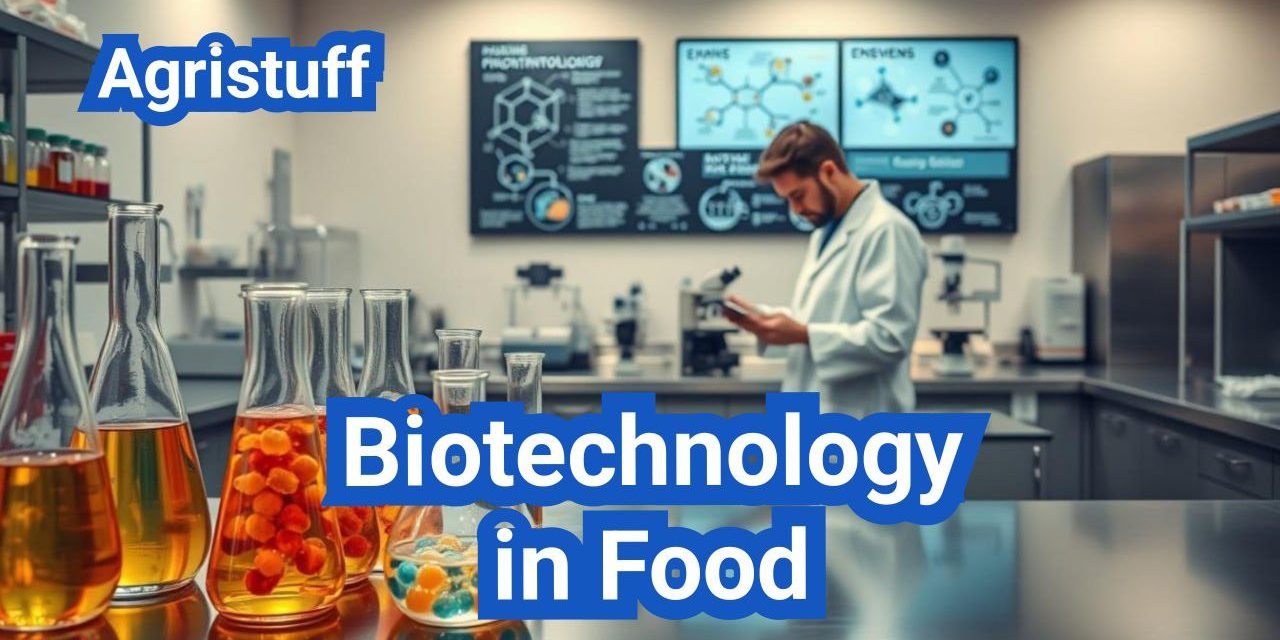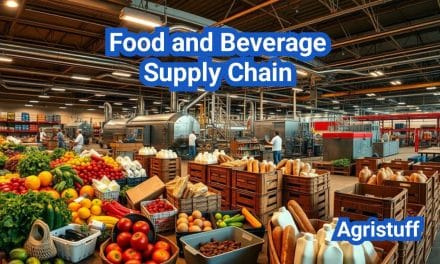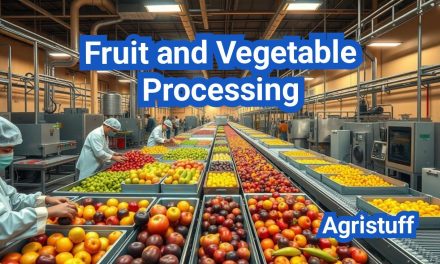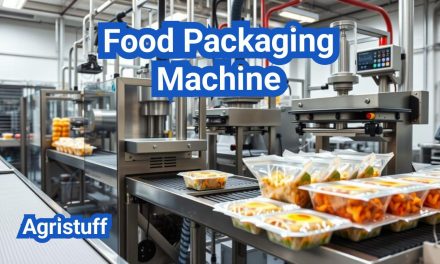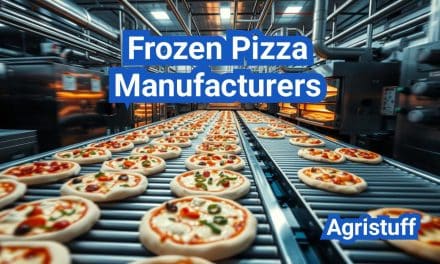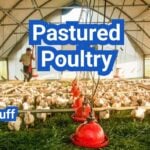The U.S. food industry is witnessing a significant transformation with the integration of biotechnology to enhance efficiency, safety, and nutritional content. The use of enzymes and cultures is becoming increasingly prevalent in creating new and improving existing food products.
Manufacturers are leveraging novel ingredients and advanced technologies to meet the growing demand for healthier and sustainable food options. This shift is driven by consumer preferences and the need for innovative solutions in food manufacturing.
Key Takeaways
- The U.S. food industry is adopting biotechnology to improve food production.
- Enzymes and cultures play a crucial role in creating new food products.
- Novel ingredients are being used to enhance nutritional content and sustainability.
- Biotechnology is enhancing efficiency and safety in food manufacturing.
- The demand for healthier and sustainable food options is driving innovation.
The Evolution of Biotechnology in Food Manufacturing
For thousands of years, biotechnology has played a crucial role in food production, with modern advancements expanding its potential. The application of biotechnological principles has transformed the way food is manufactured, processed, and consumed.
The historical development of food biotechnology is rooted in traditional practices such as fermentation, which dates back to ancient civilizations. Early forms of biotechnology were used to produce foods like bread, cheese, and beer, leveraging microorganisms to enhance flavor, texture, and preservation.
Historical Perspective of Food Biotechnology
The use of microorganisms in food production has a long history, with evidence of fermentation dating back to around 6000 BC in ancient Mesopotamia. The process was initially unregulated and based on empirical knowledge passed down through generations. As understanding of microbiology improved, so did the techniques for harnessing microorganisms in food production.
Modern Advancements in Food Manufacturing
Today, biotechnology in food manufacturing encompasses a broad range of technologies, including genetic engineering, enzyme technology, and microbial cultures. These modern advancements have significantly enhanced the efficiency, safety, and quality of food production. Techniques such as precision fermentation and the development of novel ingredients have opened new avenues for food manufacturers.
The integration of modern advancements in biotechnology has enabled the creation of healthier, more sustainable food products. For instance, the use of enzymes in food processing has improved yields and reduced waste, while microbial cultures continue to play a vital role in dairy and fermented products.
As the food industry continues to evolve, understanding the historical perspective and embracing modern advancements in biotechnology will be crucial for manufacturers looking to innovate and remain competitive.
Understanding Biotechnology in Food: Core Concepts and Principles
The integration of biotechnology in food production is enhancing efficiency, safety, and quality. This section aims to provide a comprehensive understanding of the core concepts and principles underlying food biotechnology.
Defining Food Biotechnology
Food biotechnology involves the application of biological systems, living organisms, or derivatives thereof, to develop new food products and technologies. It encompasses a broad range of techniques, from traditional fermentation processes to modern genetic engineering methods. Biotechnology has become a vital tool in the food industry, enabling manufacturers to create products with improved nutritional profiles, enhanced flavors, and extended shelf lives.
Key Biological Processes in Food Production
Several key biological processes are central to food biotechnology, including fermentation, enzymatic reactions, and microbial cultures. Fermentation, for instance, is a metabolic process that converts sugars into acids, gases, or alcohol, and is used in the production of yogurt, cheese, and alcoholic beverages. Enzymatic reactions involve the use of enzymes as biological catalysts to speed up chemical reactions, improving the efficiency and yield of food processing. Microbial cultures, comprising bacteria, yeast, or mold, are used to ferment foods, enhance flavors, and improve food safety.
These biological processes are harnessed through various techniques, including genetic engineering, which allows for the precise modification of microorganisms and enzymes to achieve desired traits. The result is a wide range of innovative food products that meet consumer demands for healthier, tastier, and more sustainable options.
Benefits of Biotechnology for Manufacturers
The adoption of biotechnology in food production offers numerous benefits for manufacturers. These include improved process efficiency, reduced production costs, and enhanced product quality. Biotechnology can also help manufacturers comply with regulatory requirements and meet consumer expectations for safe and sustainable food products. By leveraging biotechnological innovations, food manufacturers can differentiate their products in a competitive market, driving business growth and profitability.
Furthermore, biotechnology enables the development of novel ingredients and products that can address specific consumer needs, such as plant-based alternatives to traditional dairy or meat products. As the food industry continues to evolve, the role of biotechnology in shaping the future of food production is likely to become increasingly significant.
How to Identify Applications of Biotechnology in Food Production
The integration of biotechnology in food production begins with a comprehensive evaluation of current processes. Manufacturers must understand their existing production methods to identify areas where biotechnology can be effectively applied.
Assessing Current Manufacturing Processes
To assess current manufacturing processes, manufacturers should start by mapping out their production workflows. This involves identifying every step in the process, from raw material sourcing to final product packaging.
- Document each stage of production
- Identify bottlenecks or inefficiencies
- Analyze quality control measures
By understanding these elements, manufacturers can pinpoint areas where biotechnology might offer improvements.
Identifying Opportunities for Biotechnology Integration
Once current processes are understood, the next step is to identify opportunities for biotechnology integration. This involves looking for areas where biotechnology can enhance efficiency, safety, or nutritional content.
- Enzyme applications for improved processing
- Microbial cultures for fermentation or food safety
- Novel ingredients produced through precision fermentation or cell culture
Evaluating Cost-Benefit of Biotechnology Solutions
After identifying potential areas for biotechnology integration, manufacturers must evaluate the cost-benefit of these solutions. This involves comparing the potential benefits of biotechnology against the costs of implementation.
| Cost Factors | Benefit Factors |
|---|---|
| Initial investment in biotechnology | Improved efficiency in production |
| Training for staff on new technologies | Enhanced product safety |
| Potential regulatory compliance costs | Increased nutritional value of products |
By carefully evaluating these factors, manufacturers can make informed decisions about where to apply biotechnology solutions.
Implementing Enzyme Technology in Food Processing

Enzyme technology plays a crucial role in modern food processing, offering numerous benefits. Enzyme technology has become a cornerstone in the food processing industry, enhancing efficiency, safety, and nutritional content. The strategic implementation of enzymes can significantly improve manufacturing processes.
Selecting Appropriate Enzymes for Your Product
Selecting the right enzymes for a specific product is crucial. Factors such as the type of food being processed, the desired outcome (e.g., texture modification, flavor enhancement), and regulatory compliance must be considered. For instance, proteases are used to tenderize meat, while amylases are utilized in starch processing.
Optimizing Enzyme Activity in Production
Optimizing enzyme activity involves controlling factors like temperature, pH, and enzyme dosage. Temperature is particularly critical as it affects enzyme stability and activity. Manufacturers must also consider the pH level to ensure optimal enzyme performance.
Monitoring Enzyme Performance
Monitoring enzyme performance is essential to ensure consistent product quality. This involves regular analysis of enzyme activity and its impact on the final product. Advanced analytical techniques can help in assessing enzyme efficacy and making necessary adjustments.
Guide to Food Enzymes: Types, Functions, and GRAS Status
Food enzymes, with their diverse functions and GRAS status, are vital components in the production of high-quality food products. These biological catalysts play a crucial role in enhancing the efficiency, safety, and nutritional content of various food items.
Navigating the Food Enzymes GRAS List
The Generally Recognized as Safe (GRAS) list is a critical resource for food manufacturers using enzymes in their products. To navigate this list effectively, manufacturers must understand the criteria used to determine GRAS status for food enzymes. The GRAS designation is based on a thorough review of scientific data, ensuring that the enzyme is safe for consumption under the specified conditions of use.
Manufacturers can access the GRAS list through the FDA’s website, where they can search for specific enzymes and review the supporting documentation. It’s essential to stay updated on any changes or updates to the GRAS list, as new information becomes available.
Understanding Enzyme Functionality by Category
Food enzymes can be categorized based on their functions, such as carbohydrases, proteases, and lipases. Each category has specific applications in food processing.
- Carbohydrases: These enzymes break down carbohydrates into simpler sugars. Examples include amylase and glucoamylase, which are used in baking and brewing.
- Proteases: Proteases break down proteins into peptides or amino acids. They are used in meat tenderization, cheese production, and brewing.
- Lipases: Lipases catalyze the hydrolysis of fats into fatty acids and glycerol. They are used in flavor development and fat processing.
Understanding the functionality of each enzyme category helps manufacturers select the most appropriate enzymes for their specific applications.
Enzyme Sourcing and Production Methods
Food enzymes are sourced from various origins, including microbial fermentation, plant, and animal sources. Microbial fermentation is the most common method, offering advantages such as high yield and consistency.
The production of food enzymes involves several steps, including strain selection, fermentation, recovery, and formulation. Advances in biotechnology have improved the efficiency and sustainability of enzyme production.
Manufacturers must ensure that their enzyme sourcing and production methods comply with regulatory requirements and industry standards.
Microbial Cultures: Selection and Application in Food Manufacturing

Microbial cultures play a crucial role in food manufacturing, enhancing the safety, quality, and nutritional value of various products. The careful selection and application of these cultures are essential for achieving desired product characteristics and ensuring consumer safety.
Starter Cultures for Dairy Products
Starter cultures are microorganisms used to initiate fermentation in dairy products such as yogurt, cheese, and butter. These cultures contain bacteria like Lactococcus lactis and Lactobacillus acidophilus, which convert milk sugars into lactic acid, thereby preserving the milk and creating the desired flavor and texture.
The selection of starter cultures depends on the type of dairy product being manufactured. For instance, mesophilic cultures are used for products like buttermilk and sour cream, while thermophilic cultures are preferred for yogurt production.
Fermentation Cultures for Various Food Categories
Fermentation cultures are used across a wide range of food categories beyond dairy, including meats, vegetables, and grains. These cultures contain specific strains of bacteria, yeast, or mold that are chosen for their ability to ferment the substrate, enhancing flavor, texture, and nutritional content.
- Fermented meats like salami and pepperoni rely on cultures that produce lactic acid to lower the pH and inhibit pathogenic bacteria.
- Sauerkraut and kimchi are examples of fermented vegetables, where cultures like Leuconostoc and Lactobacillus species are involved.
Protective Cultures for Food Safety
Protective cultures are microbial cultures used to enhance food safety by inhibiting the growth of pathogenic and spoilage microorganisms. These cultures produce compounds like bacteriocins, which are antagonistic to pathogens such as Listeria monocytogenes.
The application of protective cultures can be particularly beneficial in ready-to-eat foods, where the risk of contamination is high. By incorporating protective cultures, manufacturers can extend shelf life and improve product safety without significantly altering the product’s sensory characteristics.
How to Develop and Maintain Culture Systems

Effective culture systems are the backbone of many food manufacturing processes, particularly those involving fermentation. These systems are critical for producing high-quality products consistently.
Setting Up Culture Propagation Systems
Setting up a culture propagation system involves several key steps. First, manufacturers must select the appropriate microbial cultures for their specific products. This selection is based on factors such as the desired product characteristics, production conditions, and regulatory compliance.
Once the cultures are selected, the next step is to establish a sterile and controlled environment for culture propagation. This typically involves using specialized equipment and facilities designed to prevent contamination.
Maintaining Culture Viability and Purity
Maintaining the viability and purity of microbial cultures is crucial for consistent product quality. Manufacturers must implement rigorous quality control measures, including regular testing for contaminants and monitoring culture performance.
To maintain culture viability, manufacturers should also adhere to proper handling and storage procedures. This includes using appropriate cryoprotectants for freezing cultures and storing them at the correct temperatures.
Scaling Culture Production for Manufacturing
Scaling culture production from laboratory scale to manufacturing scale requires careful planning and execution. Manufacturers must scale up their culture propagation processes while maintaining culture viability and purity.
This involves using larger equipment and potentially different techniques than those used in the laboratory. It’s also crucial to validate the scaled-up process to ensure it meets the required product specifications and regulatory standards.
Novel Ingredients Through Biotechnology: Implementation Guide

The integration of novel ingredients through biotechnology is revolutionizing the food manufacturing landscape. This section will explore how manufacturers can implement these innovative ingredients in their production processes.
Incorporating Precision Fermentation Ingredients
Precision fermentation is a biotechnology technique that enables the production of complex ingredients with high precision and consistency. Precision fermentation ingredients are being used in various food products, including dairy alternatives and meat substitutes.
To incorporate precision fermentation ingredients, manufacturers should first identify the specific ingredient needed for their product. They should then assess the production capabilities and costs associated with precision fermentation.
| Ingredient | Production Method | Application |
|---|---|---|
| Microbial-derived proteins | Precision fermentation | Meat substitutes |
| Recombinant enzymes | Precision fermentation | Food processing |
Working with Plant-Based Protein Alternatives
Plant-based protein alternatives are gaining popularity as consumers increasingly adopt vegan and flexitarian diets. Biotechnology is enhancing the nutritional profile and functionality of these proteins.
Manufacturers can work with plant-based protein alternatives by sourcing high-quality proteins and optimizing their formulation to meet consumer demands.
Integrating Cell-Cultured Components
Cell-cultured components, such as cell-cultured meat, are emerging as a sustainable alternative to traditional animal-derived products. This technology involves culturing animal cells in a controlled environment.
To integrate cell-cultured components, manufacturers must invest in the necessary infrastructure and ensure compliance with regulatory requirements.
By adopting novel ingredients through biotechnology, food manufacturers can improve product quality, reduce environmental impact, and meet evolving consumer preferences.
Navigating Regulatory Compliance for Biotechnology in Food

Navigating the regulatory environment for biotechnology in food requires a comprehensive understanding of various laws and guidelines. Companies involved in food biotechnology must comply with regulations set forth by multiple agencies, including the FDA and USDA.
FDA Regulations for Bioengineered Foods
The FDA regulates bioengineered foods under the Federal Food, Drug, and Cosmetic Act (FD&C Act). Bioengineered foods are considered food additives if they contain new substances not naturally found in the food. Manufacturers must ensure that these foods are safe for consumption and comply with FDA labeling requirements.
- Conduct thorough safety assessments for bioengineered foods.
- Ensure compliance with FDA guidelines for labeling bioengineered foods.
- Maintain detailed records of the bioengineering process.
Meeting USDA Requirements
The USDA’s Agricultural Marketing Service (AMS) oversees the labeling of bioengineered foods under the National Bioengineered Food Disclosure Standard (NBFDS). This standard requires food manufacturers to disclose the presence of bioengineered substances in their products.
- Determine if your product is subject to the NBFDS.
- Choose the appropriate disclosure method (text, symbol, or electronic/digital link).
- Ensure that the disclosure is clear and conspicuous on the label.
Complying with Bioengineered Food Disclosure Standards
Compliance with bioengineered food disclosure standards is critical for maintaining consumer trust and avoiding regulatory issues. Manufacturers must stay up-to-date with the latest requirements and adjust their labeling practices accordingly.
Best practices for compliance include:
- Regularly reviewing and updating labeling to reflect regulatory changes.
- Training staff on the latest disclosure requirements.
- Conducting internal audits to ensure compliance.
In conclusion, navigating regulatory compliance for biotechnology in food involves understanding and adhering to FDA regulations, USDA requirements, and bioengineered food disclosure standards. By staying informed and implementing best practices, manufacturers can ensure compliance and maintain consumer trust.
Step-by-Step Guide to GRAS Notifications for Novel Ingredients

Ensuring the safe use of novel ingredients in food products requires a thorough understanding of the GRAS notification process. The Generally Recognized as Safe (GRAS) designation is crucial for the successful introduction of new ingredients into the U.S. market.
Preparing Scientific Documentation
The foundation of a successful GRAS notification lies in comprehensive scientific documentation. This involves compiling data on the ingredient’s safety, including:
- Toxicology studies to assess potential health risks.
- Exposure assessments to determine the likely consumption levels.
- Stability and specifications data to ensure consistency and purity.
It’s essential to present this information clearly and concisely, often with the help of experts in toxicology and nutritional science.
Submitting GRAS Notifications
Once the scientific documentation is in order, the next step is to submit the GRAS notification to the FDA. This involves:
- Preparing a detailed dossier that includes all relevant safety data.
- Drafting a comprehensive GRAS notice that summarizes the safety assessment.
- Submitting the GRAS notice to the FDA for review.
The FDA will then review the submission to determine if the ingredient can be considered GRAS.
Responding to Agency Questions
After submitting a GRAS notification, manufacturers may receive questions from the FDA regarding their submission. It’s crucial to:
- Respond promptly to agency inquiries to avoid delays.
- Provide clear and concise answers to the FDA’s questions.
- Be prepared to supplement the dossier with additional data if requested.
Effective communication with the FDA can facilitate a smoother review process.
Implementing FSMA Preventive Controls for Biotechnology Processes

FSMA preventive controls play a vital role in ensuring the safety of biotechnology applications in food manufacturing. The Food Safety Modernization Act (FSMA) emphasizes the importance of preventive controls to minimize risks associated with food production.
Risk Assessment for Biotechnology Applications
Conducting a thorough risk assessment is the first step in implementing FSMA preventive controls for biotechnology processes. This involves identifying potential hazards associated with the use of biotechnology in food production, such as contamination risks or unintended allergens.
To effectively assess risks, manufacturers should consider the following:
- Evaluate the production process from raw material sourcing to final product distribution.
- Identify critical control points where preventive controls can be applied.
- Consider the potential for biological, chemical, or physical hazards.
Developing Monitoring Procedures
Once risks have been identified, developing robust monitoring procedures is essential. This involves establishing a system to continuously monitor critical control points and ensure that preventive controls are effective.
Effective monitoring procedures should include:
- Regular inspections and testing at critical control points.
- Documentation of monitoring activities and results.
- Training personnel on monitoring procedures and protocols.
Creating Corrective Action Plans
Despite robust preventive controls and monitoring procedures, deviations can occur. Therefore, it’s crucial to have corrective action plans in place to address any non-compliance or safety issues that arise.
A comprehensive corrective action plan should:
- Identify the root cause of the deviation.
- Outline specific corrective actions to be taken.
- Include procedures for verifying the effectiveness of corrective actions.
By implementing FSMA preventive controls, including thorough risk assessments, robust monitoring procedures, and effective corrective action plans, biotechnology companies can ensure the safe production of food products and comply with regulatory requirements.
Quality Assurance Systems for Biotechnology-Derived Ingredients

To guarantee the safety and efficacy of biotechnology-derived ingredients, comprehensive quality assurance systems are essential. These systems are critical for ensuring compliance with regulatory requirements and for maintaining consumer trust in food products.
Establishing Testing Protocols
Testing protocols are a cornerstone of quality assurance for biotechnology-derived ingredients. Manufacturers must develop and implement rigorous testing to verify the identity, purity, and potency of these ingredients. This involves analytical methods such as chromatography and spectroscopy to detect any contaminants or adulterants.
For instance, a company producing a novel protein through microbial fermentation would need to establish testing protocols to confirm the protein’s structure and function. This might involve mass spectrometry to verify the molecular weight and SDS-PAGE to assess purity.
Developing Documentation Systems
Effective documentation is vital for traceability and compliance. Manufacturers should maintain detailed records of production processes, including batch numbers, production dates, and quality control test results. This documentation helps in identifying and addressing any quality issues promptly.
A robust documentation system also facilitates supply chain transparency, enabling manufacturers to track the origin and movement of biotechnology-derived ingredients throughout the production process.
Creating Traceability Programs
Traceability programs are essential for quickly identifying and containing any quality issues related to biotechnology-derived ingredients. These programs involve assigning unique identifiers to batches and maintaining records of their distribution.
By implementing traceability programs, manufacturers can ensure that they can rapidly recall affected products in the event of a quality issue, thereby protecting consumers and minimizing financial losses.
Biotechnology Solutions for Enhanced Food Safety
Biotechnology is revolutionizing food safety through innovative solutions. The integration of biotechnology in food manufacturing is enhancing safety standards by introducing advanced antimicrobial systems and pathogen detection technologies. These advancements are crucial in preventing foodborne illnesses and ensuring consumer safety.
Implementing Antimicrobial Systems
Antimicrobial systems are being developed using biotechnology to reduce the presence of harmful microorganisms in food products. These systems can be integrated into food packaging or used as treatments during processing. For instance, nisin, a naturally occurring antimicrobial peptide, is used to extend the shelf life of dairy products.
Advanced Pathogen Detection Technologies
Advanced pathogen detection technologies are being implemented to quickly identify and isolate contaminated food products. These technologies utilize biotechnology to detect pathogens at very low concentrations, enabling swift action to prevent outbreaks. Techniques such as PCR (Polymerase Chain Reaction) are being used for rapid detection of pathogens like Salmonella and E. coli.
The following table compares traditional methods with biotechnology solutions for food safety:
| Criteria | Traditional Methods | Biotechnology Solutions |
|---|---|---|
| Detection Time | Longer detection times | Rapid detection |
| Accuracy | May have higher false positives | Higher accuracy |
| Cost | Generally more expensive | Cost-effective in the long run |
| Implementation | Limited by existing infrastructure | Can be integrated into existing systems |
In conclusion, biotechnology solutions are significantly enhancing food safety by providing advanced antimicrobial systems and pathogen detection technologies. These innovations are crucial for preventing foodborne illnesses and ensuring a safer food supply chain.
Case Studies: Successful Implementation of Biotechnology in Food
Through the lens of case studies, we can observe the profound impact of biotechnology on the food industry, from natural sweeteners to plant-based meats. This section highlights successful implementations of biotechnology in food production, showcasing innovations that have transformed manufacturing processes.
Rebaudioside M Fermentation for Natural Sweeteners
The production of rebaudioside M, a natural sweetener derived from Stevia rebaudiana, has been significantly enhanced through biotechnology. By utilizing microbial fermentation, manufacturers can produce rebaudioside M on a larger scale while maintaining its natural origin and improving its taste profile. This process involves the use of microorganisms engineered to produce the specific steviol glycoside, rebaudioside M, through fermentation.
Key benefits of this biotechnology application include:
- Increased yield and purity of rebaudioside M
- Reduced production costs compared to traditional extraction methods
- Consistent quality, meeting the demand for natural sweeteners in the food industry
Soy Leghemoglobin Production for Plant-Based Meat
Soy leghemoglobin, a protein found in soybeans, has been identified as a key ingredient in replicating the taste and texture of meat in plant-based meat alternatives. Biotechnology has enabled the production of soy leghemoglobin through microbial fermentation, allowing for large-scale production that meets the growing demand for plant-based products.
The use of soy leghemoglobin in plant-based meat products has been praised for its ability to mimic the organoleptic properties of meat, enhancing the consumer experience. Regulatory approvals, such as GRAS status from the FDA, have supported its adoption in the industry.
Enzyme Applications in Dairy Processing
Enzymes play a crucial role in dairy processing, from cheese production to milk processing. Biotechnology has led to the development of novel enzymes with improved properties, such as heat stability and specificity, enhancing the efficiency and quality of dairy products.
For instance, the use of chymosin, a cheese-making enzyme, produced through microbial fermentation, has become a standard practice. This enzyme offers a more consistent and efficient alternative to traditional rennet, improving cheese production processes.
The successful implementation of biotechnology in these areas demonstrates its potential to transform the food industry, offering more sustainable, efficient, and innovative production methods.
Addressing Consumer Concerns About Biotechnology in Food
The growing use of biotechnology in food production has sparked consumer concerns, which must be addressed through transparent communication. As consumers become more aware of the technologies used in their food, manufacturers must be prepared to provide clear information about the benefits and safety of biotechnology.
Developing Transparent Communication Strategies
Transparent communication is key to alleviating consumer concerns. This involves not only providing accurate information but also doing so in a way that is accessible and understandable to the general public. Manufacturers should consider the following strategies:
- Clearly labeling products that use biotechnology
- Providing educational resources on their websites and in-store
- Engaging with consumers through social media and other channels
By adopting these strategies, manufacturers can build trust with their consumers and demonstrate their commitment to transparency.
Educating Consumers About Biotechnology Benefits
Consumer education is crucial in addressing concerns about biotechnology. By highlighting the benefits of biotechnology, such as improved nutritional content, reduced environmental impact, and enhanced food safety, manufacturers can help consumers understand the value of these technologies.
Key benefits to emphasize include:
- Nutritional enhancements that improve public health
- Sustainable production methods that reduce environmental footprint
- Innovative solutions for food safety and quality
Responding to Common Misconceptions
Despite the benefits, misconceptions about biotechnology persist. Manufacturers must be prepared to address these misconceptions directly, providing scientific evidence and expert opinions to support their claims.
For instance, some consumers may believe that biotechnology is inherently risky or that it is not regulated. By providing factual information and highlighting regulatory oversight, manufacturers can help alleviate these concerns.
In conclusion, addressing consumer concerns about biotechnology in food requires a multifaceted approach that includes transparent communication, consumer education, and direct responses to misconceptions. By implementing these strategies, food manufacturers can build consumer trust and confidence in the safety and benefits of biotechnology.
Future Trends in Food Biotechnology to Prepare For
As we look to the future, food biotechnology is poised to address some of the most pressing challenges in food production. The industry is on the cusp of significant changes driven by emerging technologies, sustainability needs, and evolving consumer preferences.
Emerging Technologies on the Horizon
The future of food biotechnology will be shaped by several emerging technologies. Precision fermentation is one such innovation that allows for the production of high-quality ingredients with improved nutritional profiles. This technology is expected to play a crucial role in the development of novel food products.
Cell-cultured ingredients are another area of growth, offering alternatives to traditional animal-derived products. Companies like Memphis Meats are already pioneering this technology, producing cell-cultured meat products that are both sustainable and appealing to consumers.
“The future of food is not just about feeding people, it’s about creating a sustainable food system that benefits both the planet and its inhabitants.” –
Unknown
Sustainability Opportunities Through Biotechnology
Biotechnology offers numerous opportunities for enhancing sustainability in food production. By developing ingredients and products with reduced environmental impact, manufacturers can meet growing consumer demand for eco-friendly options.
| Sustainability Aspect | Biotechnology Application | Benefit |
|---|---|---|
| Water Conservation | Drought-resistant crops | Reduced water usage in agriculture |
| Reduced Waste | Precision fermentation | More efficient production processes |
| Lower Carbon Footprint | Plant-based alternatives | Reduced greenhouse gas emissions |
Preparing for Changing Consumer Preferences
Consumer preferences are shifting towards healthier, more sustainable food options. Manufacturers must be prepared to adapt to these changes by incorporating biotechnology into their product development processes.
- Developing products with cleaner labels
- Incorporating novel ingredients produced through biotechnology
- Enhancing nutritional profiles through bioengineering
By staying ahead of these trends and leveraging the latest advancements in food biotechnology, manufacturers can not only meet but exceed consumer expectations, driving growth and innovation in the industry.
Creating Your Biotechnology Implementation Roadmap
Implementing biotechnology in food production requires careful planning and execution. To create a successful biotechnology implementation roadmap, manufacturers in the food industry must consider several key factors.
A well-structured roadmap begins with assessing current manufacturing processes and identifying opportunities for biotechnology integration. This involves evaluating the cost-benefit of biotechnology solutions and selecting the most suitable technologies for your products.
By understanding the regulatory landscape and ensuring compliance with FDA and USDA requirements, manufacturers can navigate the complexities of biotechnology implementation. Developing a robust quality assurance system and implementing preventive controls are also crucial steps.
As the food industry continues to evolve, staying informed about emerging trends and technologies is essential. By creating a comprehensive biotechnology implementation roadmap, manufacturers can position themselves for success and capitalize on the benefits of biotechnology.
FAQ
What is food biotechnology?
Food biotechnology is the use of biological systems, living organisms, or derivatives thereof, to develop new products and technologies in the food industry.
How is biotechnology used in food production?
Biotechnology is used in food production to improve crop yields, enhance nutritional content, and develop novel ingredients, among other applications.
What are the benefits of biotechnology in food manufacturing?
Biotechnology in food manufacturing offers several benefits, including improved efficiency, reduced costs, and enhanced product quality.
What are some examples of biotechnology-derived ingredients?
Examples of biotechnology-derived ingredients include precision fermentation ingredients, plant-based protein alternatives, and cell-cultured components.
How are enzymes used in food processing?
Enzymes are used in food processing to break down complex molecules, improve texture, and enhance flavor.
What is the GRAS list, and how does it relate to food enzymes?
The GRAS (Generally Recognized as Safe) list is a list of substances that are considered safe for use in food products. Food enzymes that are GRAS-compliant have been deemed safe for use in food processing.
How are microbial cultures used in food manufacturing?
Microbial cultures are used in food manufacturing to ferment foods, improve texture, and enhance flavor.
What are the regulatory requirements for biotechnology in food?
Regulatory requirements for biotechnology in food include FDA regulations for bioengineered foods, USDA requirements, and bioengineered food disclosure standards.
How do I submit a GRAS notification for a novel ingredient?
To submit a GRAS notification, you must prepare scientific documentation, submit the notification to the FDA, and respond to any agency questions.
What is FSMA, and how does it relate to biotechnology processes?
FSMA (Food Safety Modernization Act) is a law that regulates food safety in the United States. Biotechnology processes must comply with FSMA requirements, including risk assessment, monitoring procedures, and corrective action plans.
How can biotechnology enhance food safety?
Biotechnology can enhance food safety through the implementation of antimicrobial systems and advanced pathogen detection technologies.
What are some emerging trends in food biotechnology?
Emerging trends in food biotechnology include precision fermentation, cell-cultured meat, and sustainability opportunities through biotechnology.
How can I address consumer concerns about biotechnology in food?
To address consumer concerns, develop transparent communication strategies, educate consumers about biotechnology benefits, and respond to common misconceptions.
Conclusion of: Biotechnology in Food
From bakeries to beverage plants, biotechnology in food uses living systems—microbes, enzymes, and carefully selected cell lines—to make safer, tastier, and more efficient products for U.S. consumers. In practice, that means using fermentation to build flavor, enzymes to tailor texture, and precision methods to produce novel ingredients under clear federal oversight. Teams that integrate R&D, quality, and regulatory from day one scale faster and avoid surprises on labeling and safety. FDA overview of biotechnology in food.
The U.S. oversight map for biotechnology in food
To commercialize biotechnology in food, manufacturers navigate the “Coordinated Framework”: FDA regulates most foods and ingredients, USDA (including FSIS) regulates meat, poultry, and some egg products, and EPA covers certain biotech microbes and pesticides. Understanding who regulates what clarifies premarket expectations and labeling. EPA’s Coordinated Framework update.
Why enzymes and cultures anchor biotechnology in food
Enzymes and microbial cultures are the workhorses of biotechnology in food, converting starches, building characteristic flavors, and controlling spoilage at lower temperatures and with fewer inputs than purely chemical routes. Fermentation has re-emerged as a versatile platform for clean-label innovation across U.S. categories. IFT on fermentation in food.
Enzymes 101: scope and status in biotechnology in food
Whether you’re formulating bread, juice, or plant proteins, biotechnology in food typically relies on enzyme preparations (amylases, pectinases, proteases, oxidases). Many have GRAS status and long safety records. R&D teams often start by checking the federal lists and prior FDA evaluations when scoping new uses. FDA partial list of enzyme preparations.
Labeling processing aids within biotechnology in food
In U.S. labeling, many enzyme uses in biotechnology in food are “processing aids,” meaning the enzyme acts during processing but not in the finished food; such incidental additives can be exempt from ingredient declaration if criteria are met. This distinction is crucial for clean labels. 21 CFR §101.100 on incidental additives.
Lactase in dairy: a model use-case of biotechnology in food
Lactase (β-galactosidase) illustrates how biotechnology in food solves real consumer needs: hydrolyzing lactose enables lactose-free milks and yogurts while maintaining sweetness and functionality. FDA affirms specific lactase sources as GRAS with defined conditions of use. 21 CFR §184.1388 (lactase from K. lactis).
Nisin for safety: fermentation’s preservative in biotechnology in food
Nisin, a bacteriocin from lactic acid bacteria, is widely used in biotechnology in food as an antimicrobial to help control spoilage and certain pathogens in cheese, canned foods, and spreads—under specified levels and foods. 21 CFR §184.1538 (nisin).
Practical enzyme applications across categories in biotechnology in food
U.S. formulators employ biotechnology in food enzymes to: keep bread soft (amylases/xylanases), improve juice yield and clarity (pectinases), tailor plant-protein texture (proteases), stabilize foams (glucose oxidase), and reduce off-notes (lipoxygenase management). These tools help meet sensory targets with fewer additives. IFT on enzymes in manufacturing.
Starter cultures: flavor, texture, and safety in biotechnology in food
From cheese to kimchi, starter cultures underpin biotechnology in food by acidifying, producing aroma compounds, and outcompeting spoilage organisms. Selecting the right strain and dose allows manufacturers to tune flavor and shelf life while maintaining safety. FAO primer on probiotics and cultures.
Probiotics vs. starter cultures in biotechnology in food
In biotechnology in food, not all fermented foods are “probiotic.” Probiotic claims require evidence that specific live strains confer a health benefit at effective doses; many processing cultures are used for technological functions only and make no health claims. NIH ODS health-professional fact sheet on probiotics.
Protective cultures and phages: targeted control in biotechnology in food
Protective cultures and bacteriophages extend biotechnology in food into precision safety tools. For example, FDA has evaluated a Listeria phage (P100) intended for use on certain cheeses, reflecting a case-by-case, science-based approach. FDA GRAS Notice 198 (Listeria phage).
Precision fermentation proteins: a new chapter in biotechnology in food
Companies increasingly use precision fermentation within biotechnology in food to make specific proteins with animal-like functionality—such as non-animal β-lactoglobulin—for drinks, desserts, and nutrition products. FDA’s “no questions” letters detail identity and safety considerations. FDA GRN 863 (β-lactoglobulin).
Heme for plant-based meat: sensory science via biotechnology in food
To deliver meaty flavor and color, biotechnology in food uses soy leghemoglobin produced by engineered yeast, enabling convincing plant-based burgers under defined conditions of use reviewed by FDA. FDA GRN 737 (soy leghemoglobin).
Fermentation-derived sweeteners in biotechnology in food
“Rare” stevia molecules like Reb M can be produced by fermentation to achieve better taste profiles at scale, reflecting how biotechnology in food improves sensory outcomes while managing cost-in-use. FDA’s GRAS letters describe manufacturing and safety. FDA GRN 882 (Rebaudioside M via fermentation).
Bioengineered (BE) disclosure: labeling within biotechnology in food
When ingredients made via biotechnology in food meet the statutory definition of “bioengineered,” USDA’s National Bioengineered Food Disclosure Standard (NBFDS) requires disclosure for retail foods, with specific records, lists, and options for how to disclose. USDA AMS BE disclosure standard.
FSMA & CGMP: safety backbone for biotechnology in food
Irrespective of novelty, biotechnology in food must sit on a robust FSMA-compliant food safety plan—hazard analysis, preventive controls, supply-chain controls, environmental monitoring where appropriate, and current good manufacturing practice. FDA Preventive Controls for Human Food.
Allergens and processing aids in biotechnology in food
Allergen rules still apply in biotechnology in food even when ingredients are processing aids. If an enzyme or culture is derived from a major allergen source, labeling obligations may still trigger, and sesame became the ninth major allergen in 2023 under the FASTER Act. FDA on sesame as the 9th major allergen.
When meat or poultry are involved in biotechnology in food
Products that combine biotechnology in food with meat or poultry fall under FSIS jurisdiction for labeling and certain ingredient approvals. FSIS maintains a “Safe and Suitable” list that governs allowable substances and levels in inspected products. USDA FSIS Directive 7120.1.
Cell-cultured foods: dual oversight in biotechnology in food
Cell-cultured foods reflect a frontier of biotechnology in food. FDA conducts premarket consultations evaluating safety; FSIS oversees harvest/processing for meat and poultry establishments and labeling, under a formal interagency agreement. FDA on cell-cultured food consultations.
FSIS role inside cultured-meat establishments in biotechnology in food
For cell-cultured meat and poultry, biotechnology in food intersects with FSIS oversight on-site, from cell harvest through finished product. Understanding documentation, HACCP alignment, and labeling coordination helps teams build compliant plants. USDA FSIS Directive 7800.1.
GRAS tools and inventories for biotechnology in food
Before filing or formulating, biotechnology in food teams consult FDA tools: the GRAS Notice Inventory, partial lists of affirmed GRAS microorganisms and microbial-derived ingredients, and public decision letters that clarify identity and specifications. FDA list: microbes & microbial-derived ingredients.
Staying current: new clearances in biotechnology in food
Because biotechnology in food evolves rapidly, regulatory and R&D teams monitor newly posted notices to spot enzymes, cultures, or novel compounds that may expand formulation options or clarify precedent for similar molecules. FDA: recently published GRAS notices.
Supplier approval and documentation in biotechnology in food
A robust supplier program is the backbone of biotechnology in food. Beyond GRAS letters, QA teams verify identity, specs, contaminants, and change-control—and cross-check regulatory status via consolidated lists of authorized substances. FDA Food Additive Status List.
R&D to market: integrating compliance in biotechnology in food
Winning teams align science, safety, and labeling early in biotechnology in food projects: choose the right regulatory pathway (GRAS, food additive, or color additive for pigments), build FSMA-ready documentation, maintain traceability, and plan BE disclosure where applicable—so commercialization proceeds smoothly. FDA GRAS Notice Inventory (search portal).
Final thought
Biotechnology in food empowers U.S. manufacturers to deliver better flavor, functionality, safety, and sustainability—provided R&D, regulatory strategy, and quality systems move together. Treat enzymes, cultures, and precision-fermented ingredients as strategic assets, build dossiers early, and monitor new GRAS postings so innovation reaches shelves without compliance setbacks.
Sources & References
- FDA: Regulation of Plant & Animal Biotechnology Products
- EPA: Coordinated Framework Update
- IFT: The Wonderful World of Fermentation
- FDA: Enzyme Preparations (Partial List)
- eCFR: 21 CFR §101.100
- eCFR: 21 CFR §184.1388 (Lactase)
- eCFR: 21 CFR §184.1538 (Nisin)
- IFT: Enzymes in Manufacturing
- FAO: Probiotics & Cultures
- NIH ODS: Probiotics Fact Sheet
- FDA GRN 198: Listeria Phage
- FDA GRN 863: β-Lactoglobulin
- FDA GRN 737: Soy Leghemoglobin
- FDA GRN 882: Rebaudioside M
- USDA AMS: BE Disclosure Standard
- FDA: FSMA Preventive Controls
- USDA FSIS: Directive 7120.1
- FDA: Cell-Cultured Food Consultations
- USDA FSIS: Directive 7800.1
- FDA: Microbes & Microbial-Derived Ingredients
- FDA: Recently Published GRAS Notices
- FDA: GRAS Notice Inventory (Search)

